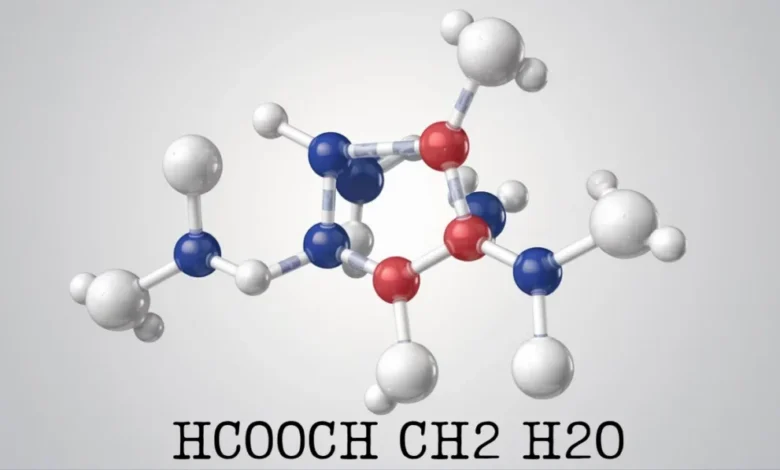Exploring HCOOCH CH2 H2O: A Journey Through Molecular Mysteries

Ever heard of HCOOCH CH2 H2O and thought, “What in the world is that?” Don’t worry—you’re not alone! This mysterious compound might sound like a jumble of letters and numbers, but it’s a fascinating molecule that packs a punch in the world of chemistry. With roots in organic and aqueous reactions, HCOOCH CH2 H2O (formate methylene hydrate) is a bit of a showstopper in the scientific community. So, buckle up, because we’re diving into the who, what, why, and how of this intriguing chemical. Let’s roll!
What Exactly Is HCOOCH CH2 H2O?
Breaking Down the Formula
To get the ball rolling, let’s dissect this compound:
- HCOOCH: This is formate methylene, a group known for its role in ester and organic chemistry.
- CH2 H2O: This part combines methylene (CH2) and water (H2O), adding a fascinating hydration element.
When these components merge, you get a molecule that’s as much a puzzle as it is a powerhouse.
Why Is It Special?
- Dual Nature: HCOOCH CH2 H2O straddles the line between organic and inorganic, making it a chameleon in the chemistry world.
- Reactivity: This compound loves to interact, making it useful in synthesis reactions.
- Versatility: It pops up in lab experiments, environmental processes, and industrial applications.
How Is HCOOCH CH2 H2O Used?
Laboratory Applications
In the lab, HCOOCH CH2 H2O is like that Swiss Army knife you never knew you needed. Chemists often use it in:
- Catalytic Reactions: It’s a key player in forming larger, more complex molecules.
- Organic Synthesis: Need to build something intricate? This molecule’s got your back.
- Research: From studying reaction mechanisms to modeling environmental interactions, it’s a go-to.
Environmental Significance
You wouldn’t guess it, but this compound plays a role in atmospheric chemistry. When it reacts with other molecules, it can:
- Help form or break down pollutants.
- Participate in water-cycle interactions.
Industrial Relevance
Industries love anything that’s versatile, and HCOOCH CH2 H2O is no exception:
- Solvents: It’s used as a specialized solvent for niche applications.
- Intermediates: Manufacturers utilize it to create more complex products.
- Green Chemistry: Its reactions are often eco-friendly—a big plus these days.
The Science Behind HCOOCH CH2 H2O
Formation and Reactions
This molecule doesn’t just materialize out of thin air! It’s usually formed by reacting:
- Formates with methylene groups.
- Methylene compounds with water in controlled conditions.
Once formed, it’s highly reactive, participating in:
- Esterification: The formation of esters.
- Hydration-Dehydration Cycles: Switching between hydrated and anhydrous states.
Challenges and Limitations
Of course, every rose has its thorn. Some hurdles include:
- Stability Issues: The compound isn’t the most stable under extreme conditions.
- Cost: Synthesizing it can be pricey.
- Handling Requirements: It’s sensitive, so you’ve gotta handle it with care.
Fun Facts About HCOOCH CH2 H2O
Let’s lighten things up with some quirky tidbits:
- It’s a darling of green chemists because its reactions often produce minimal waste.
- In the wild, you might find traces of this compound in extreme environments like hydrothermal vents.
- Despite its complicated name, it’s surprisingly simple in structure!
FAQs About HCOOCH CH2 H2O
1. What is the primary use of HCOOCH CH2 H2O?
Its main claim to fame is as a reactive agent in organic synthesis and catalytic reactions.
2. Is it safe to handle?
It’s generally safe when handled properly, but like most chemicals, you’ll need to wear protective gear and follow lab protocols.
3. Can it be found naturally?
While it’s rare, traces might occur in specialized environmental conditions like hydrothermal systems.
4. Is it expensive to produce?
Yep, synthesis can be costly due to the precision and materials required.
5. What industries use it?
You’ll find it in research labs, niche manufacturing sectors, and even environmental studies.
Conclusion
And there you have it—the ins and outs of HCOOCH CH2 H2O! This molecule might not be a household name, but it’s a cornerstone of many scientific and industrial processes. From its quirky dual nature to its versatility in applications, it’s clear why chemists and industries alike hold it in high regard. Next time you come across a cryptic chemical formula, don’t sweat it—there’s always a fascinating story behind those letters and numbers. Happy experimenting!



